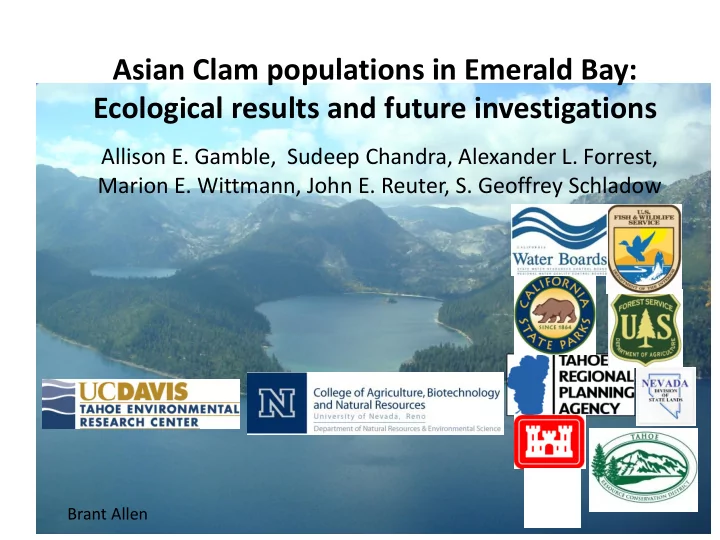

Asian Clam populations in Emerald Bay: Ecological results and future investigations Allison E. Gamble, Sudeep Chandra, Alexander L. Forrest, Marion E. Wittmann, John E. Reuter, S. Geoffrey Schladow Brant Allen
Asian clam discovery in Emerald Bay • Discovered in 2008 • Potential problem because of aesthetics, nutrient excretion, further spread in to the bay Jaxshells.org
Emerald Bay Sill Lake Tahoe Jim Markle
Comparison: 2011 vs. 2009 • 3.5 acres (yellow) in 2009 • 5.5 acres (red) in 2011 • Low density (1- 100 clams/m 2 )
Asian clam control: Pilot study Lake Tahoe Emerald Bay
Pilot study: Methods Brant Allen May 2011-May 2012: Two 10x100 foot bottom barriers
Pilot study: Data collected • Dissolved oxygen • Clam mortality, reproduction • Currents, velocities, temperature • Sediment porosity, permeability • Effect of biological supplementation of the barriers
Pilot study: Data collected • Dissolved oxygen • Clam mortality, reproduction • Currents, velocities, temperature • Sediment porosity, permeability • Effect of biological supplementation of the barriers
Dissolved oxygen Brant Allen
Dissolved oxygen (mg/L) Marla Bay DO
Emerald Bay DO 120 Dissolved oxygen (% saturation) 100 80 60 40 20 0 May 2011 October 2011 January 2012 May 2012
Emerald Bay DO 120 Dissolved oxygen (% saturation) Above mats 100 80 60 40 Below mats 20 0 May 2011 October 2011 January 2011 May 2011
Monitoring of Barriers for Clam Dynamics • Ponar, 1 m 2 quadrats • Analysis at UNR (Chandra lab) UCD TERC
Monitoring of Existing Bottom Barriers for Clam Dynamics: Final Results • Control: 14% mortality • Barriers: average 80% mortality – Barrier 1: 88% mortality, Barrier 2: 71% mortality Brant Allen • No significant difference between egg numbers of live clams in barriers vs. controls Brant Allen
Effect of biological supplementation of bottom barriers
BOD barriers • Rubber + Jute • Rubber + Jute & Straw
Deployment: • Late March-May 2012 • in line with larger clam mats
BOD barriers: Jute Results
BOD barriers: Jute + Straw Results
Future Directions • Continue: Interpretation of pilot study results • Continue: Research on causes of patterns in DO fluctuations, biological mechanisms causing clam mortality under the large barriers • BOD barriers: larger scale, materials All leading to larger scale management efforts
Acknowledgements • Katie Webb, Brant Allen, Annie Caires, Tim Caldwell, Christine Ngai • UC Davis and UNR staff • Asian Clam Working Group • Lahontan RWQCB, TRPA, TRCD • US Forest Service, US Fish and Wildlife Service, CA State Parks • CA State Lands Commission, Army Corps of Engineers, NV Division of State Lands
Recommend
More recommend